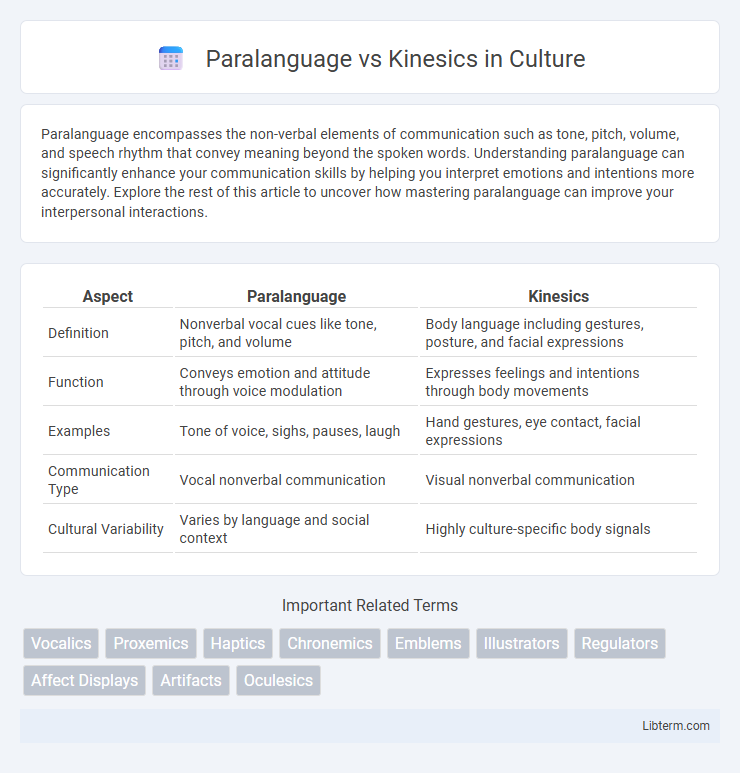Paralanguage encompasses the non-verbal elements of communication such as tone, pitch, volume, and speech rhythm that convey meaning beyond the spoken words. Understanding paralanguage can significantly enhance your communication skills by helping you interpret emotions and intentions more accurately. Explore the rest of this article to uncover how mastering paralanguage can improve your interpersonal interactions.
Table of Comparison
| Aspect | Paralanguage | Kinesics |
|---|---|---|
| Definition | Nonverbal vocal cues like tone, pitch, and volume | Body language including gestures, posture, and facial expressions |
| Function | Conveys emotion and attitude through voice modulation | Expresses feelings and intentions through body movements |
| Examples | Tone of voice, sighs, pauses, laugh | Hand gestures, eye contact, facial expressions |
| Communication Type | Vocal nonverbal communication | Visual nonverbal communication |
| Cultural Variability | Varies by language and social context | Highly culture-specific body signals |
Introduction to Paralanguage and Kinesics
Paralanguage encompasses vocal elements such as tone, pitch, volume, and speech rate that convey meaning beyond words in communication. Kinesics involves body movements, including facial expressions, gestures, posture, and eye contact, which provide nonverbal cues essential for interpreting messages. Understanding both paralanguage and kinesics is crucial for decoding the full context of interpersonal interactions and enhancing effective communication.
Defining Paralanguage: Beyond Spoken Words
Paralanguage encompasses the vocal elements accompanying speech, such as tone, pitch, volume, and speech rate, which convey emotions and attitudes beyond the actual words spoken. It plays a crucial role in communication by providing context, emphasizing meaning, and expressing feelings that words alone may not capture. Unlike kinesics, which involves body movements and gestures, paralanguage focuses strictly on vocal cues that shape interpersonal interactions.
Understanding Kinesics: The Power of Body Language
Kinesics, the study of body language, encompasses gestures, facial expressions, posture, and eye movements that convey emotions and intentions beyond spoken words. Understanding kinesics enhances communication effectiveness by revealing unspoken feelings and attitudes, often providing insight into true thoughts and emotions. Unlike paralanguage, which focuses on vocal cues such as tone and pitch, kinesics relies on observable physical behaviors to interpret meaning in interpersonal interactions.
Key Differences Between Paralanguage and Kinesics
Paralanguage involves vocal elements like tone, pitch, and volume that convey emotion and meaning beyond words, while kinesics refers to body language, including gestures, facial expressions, and posture. Paralanguage is primarily auditory communication enhancing verbal messages, whereas kinesics is visual communication expressing attitudes and emotions nonverbally. Both are crucial components of nonverbal communication but operate through different sensory channels and serve distinct roles in interpreting messages.
The Role of Paralanguage in Communication
Paralanguage plays a crucial role in communication by conveying emotions, attitudes, and intentions through vocal elements such as tone, pitch, volume, and speech rate, which often provide context beyond the actual words spoken. These vocal characteristics help listeners interpret the speaker's feelings and enhance message clarity, making communication more effective. Paralanguage works alongside kinesics, which involves body movements and facial expressions, to create a richer, multi-dimensional understanding of interpersonal interactions.
How Kinesics Influences Social Interaction
Kinesics, the study of body language, plays a crucial role in social interaction by conveying emotions, intentions, and social cues nonverbally. Facial expressions, gestures, posture, and eye contact shape communication dynamics and influence perceptions of trustworthiness, dominance, and empathy. Unlike paralanguage, which involves vocal elements like tone and pitch, kinesics provides visual feedback that helps regulate conversations and establish social bonds.
Cultural Variations in Paralanguage and Kinesics
Cultural variations in paralanguage, such as tone, pitch, and speech rate, significantly influence communication styles across diverse societies, affecting how emotions and intentions are interpreted. Kinesics, encompassing body language like gestures, facial expressions, and posture, varies widely between cultures, where a gesture in one culture may convey respect but offense in another. Understanding these cultural differences in paralanguage and kinesics enhances cross-cultural communication by reducing misinterpretations and promoting effective interpersonal interactions.
Common Examples of Paralanguage and Kinesics
Paralanguage includes vocal elements such as tone, pitch, volume, and speech rate, which convey emotions and attitudes beyond spoken words. Kinesics involves body movements like facial expressions, gestures, posture, and eye contact that communicate nonverbal messages. Common examples of paralanguage are a rising intonation indicating a question and varied speech speed expressing excitement, while kinesics examples include smiling to show friendliness and crossed arms signaling defensiveness.
The Impact of Nonverbal Cues on Communication Effectiveness
Paralanguage, encompassing vocal elements such as tone, pitch, and volume, significantly shapes the emotional context and clarity of spoken messages. Kinesics, involving body language including gestures, facial expressions, and posture, conveys attitudes and reinforces verbal communication nonverbally. The combined impact of paralanguage and kinesics on communication effectiveness lies in their ability to enhance understanding, regulate interactions, and express emotions beyond words.
Integrating Paralanguage and Kinesics for Better Communication
Integrating paralanguage, which includes vocal elements like tone, pitch, and volume, with kinesics, the study of body language such as gestures, facial expressions, and posture, enhances overall communication effectiveness by conveying emotions and intentions more clearly. Effective use of vocal cues aligned with appropriate body movements can reduce misunderstandings and build rapport in personal and professional interactions. Mastery of both paralanguage and kinesics enables communicators to deliver messages with greater impact and authenticity.
Paralanguage Infographic

 libterm.com
libterm.com